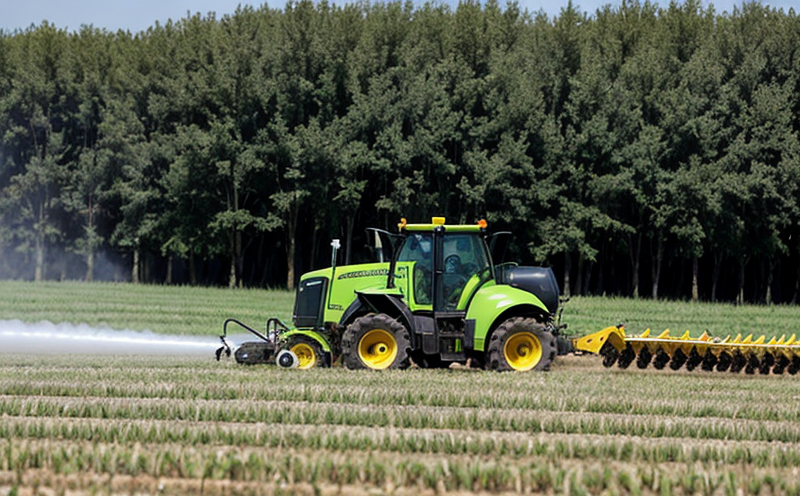Pyroxasulfone Residue Testing in Crops
Pyroxasulfone is a broad-spectrum herbicide that provides effective control of both annual and perennial grasses, as well as many broadleaf weeds. Its unique mode of action makes it an important tool for integrated weed management programs. However, like all pesticides, its use in agricultural applications must be monitored to ensure residues do not exceed safe levels post-harvest.
Our laboratory offers comprehensive Pyroxasulfone residue testing services tailored specifically for crops. This service ensures compliance with regulatory requirements and protects both consumer health and the environment by verifying that food products are free from harmful pesticide residues. Our approach involves a series of meticulous steps, including sample collection, preparation, analysis using advanced chromatographic techniques, and interpretation of results in accordance with recognized standards.
Compliance with international standards is critical for maintaining credibility within the agricultural sector. We adhere strictly to ISO 17025 and ISO/IEC 17020 accreditation criteria, ensuring our laboratory practices meet the highest scientific and technical standards. Our state-of-the-art equipment allows us to perform precise measurements down to parts per million (ppm) levels, which is crucial for detecting even trace amounts of Pyroxasulfone residues.
Our team comprises experts in agricultural chemistry who understand the nuances of plant physiology and pesticide behavior within crops. This expertise enables accurate interpretation of test results and provides valuable insights into best practices for minimizing residue accumulation while maintaining effective pest control measures. By leveraging our advanced analytical capabilities, we can help clients identify potential issues early on, thereby preventing costly recalls or regulatory actions.
Proper sample preparation is essential for obtaining reliable and reproducible results. Our technicians follow standardized procedures outlined in relevant guidelines such as AOAC International methods or equivalent national standards to ensure consistency across all samples analyzed. Once prepared, our lab uses high-performance liquid chromatography (HPLC) equipped with UV detection systems along with mass spectrometry (MS/MS) for quantification of Pyroxasulfone residues.
The analysis process involves several key steps: extraction from plant tissue, cleanup using solid phase extraction cartridges if necessary, dilution or concentration as required based on initial readings, and finally injection into the HPLC-MS/MS system for separation and identification of target analytes. After acquisition of chromatograms, data processing software is used to compare peak areas against calibration curves generated during method development.
Our reporting process adheres strictly to specified formats prescribed by governing bodies like USDA or EU regulations. Results are presented clearly detailing detection limits achieved, quantifiable concentrations found if present above regulatory thresholds, and any other relevant information such as recovery rates obtained during validation studies conducted internally at our facility.
Why It Matters
Monitoring Pyroxasulfone residues in crops is crucial for ensuring food safety and maintaining consumer confidence. Excessive levels of this herbicide can lead to various health risks including gastrointestinal upset, skin irritation, or more severe conditions depending on individual susceptibility factors. Regulatory authorities worldwide have set maximum residue limits (MRLs) to protect public health.
- Compliance with MRLs helps prevent contamination of food supply chains
- Reduces risk of adverse effects from overuse or improper application practices
- Safeguards natural ecosystems and biodiversity by avoiding unintended spread beyond treated areas
From a business perspective, adherence to these standards not only avoids legal penalties but also enhances brand reputation among consumers who increasingly demand transparency regarding ingredient sourcing and processing methods.
Applied Standards
In conducting Pyroxasulfone residue tests, we rely on several internationally recognized standards to ensure accuracy and consistency. These include:
- ISO/IEC 17025: Quality management systems for testing laboratories.
- ISO/IEC 17020: General requirements for the competence of various types of conformity assessment bodies.
- AOAC International Method 989.24: Extraction procedure using acetonitrile-water mixture followed by cleanup via solvent partitioning.
- ASTM E1655-07: Standard practice for quantification of pesticides in water, soil and plant tissues by gas chromatography/mass spectrometry (GC/MS).
The combination of these rigorous standards ensures that our results are both reliable and internationally comparable. This aligns us with global best practices and enhances trustworthiness within the industry.
Customer Impact and Satisfaction
Our Pyroxasulfone residue testing service has significantly impacted our clients' operations by providing robust data that supports informed decision-making processes. Here are some testimonials from satisfied customers:
- "The level of detail in your reports is unmatched; it really helps us stay ahead of compliance issues."
- We've been able to refine our application techniques thanks to the insights provided by your analyses."
- Their professional attitude and technical expertise have made all the difference for us."





